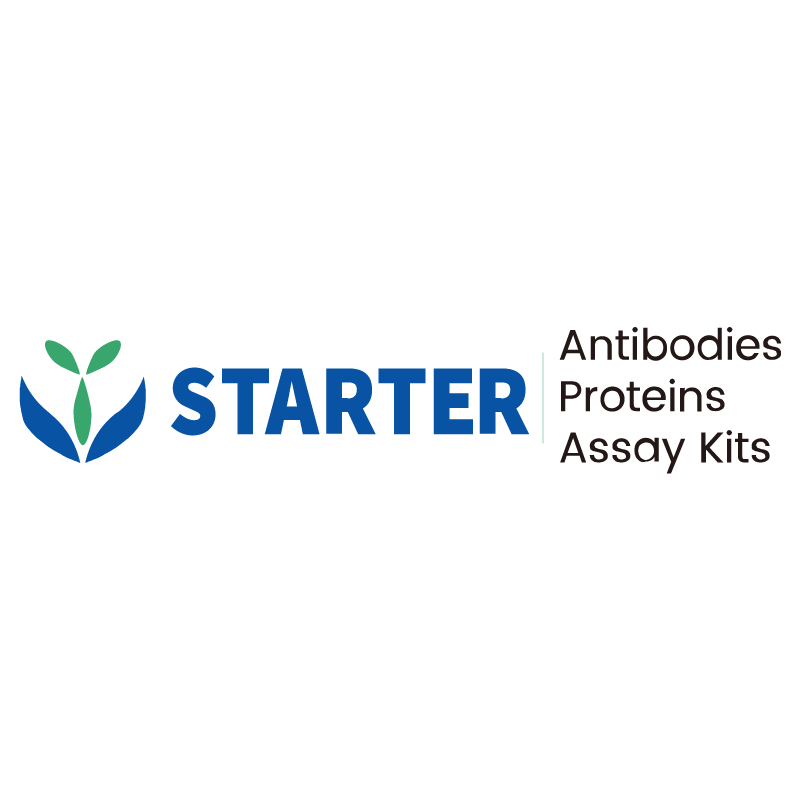WB result of Neuropilin 1 Recombinant Rabbit mAb
Primary antibody: Neuropilin 1 Recombinant Rabbit mAb at 1/1000 dilution
Lane 1: Jurkat whole cell lysate 20 µg
Lane 2: A549 whole cell lysate 20 µg
Lane 3: MDA-MB-231 whole cell lysate 20 µg
Lane 4: PC-3 whole cell lysate 20 µg
Lane 5: HUVEC whole cell lysate 20 µg
Negative control: Jurkat whole cell lysate
Secondary antibody: Goat Anti-rabbit IgG, (H+L), HRP conjugated at 1/10000 dilution
Predicted MW: 103 kDa
Observed MW: 120~130 kDa
Product Details
Product Details
Product Specification
| Host | Rabbit |
| Antigen | Neuropilin 1 |
| Synonyms | Vascular endothelial cell growth factor 165 receptor; CD304; NRP1; NRP, VEGF165R |
| Immunogen | Synthetic Peptide |
| Location | Cell membrane, Cytoplasm |
| Accession | O14786 |
| Clone Number | S-1453-6 |
| Antibody Type | Recombinant mAb |
| Isotype | IgG |
| Application | WB, IHC-P, IP |
| Reactivity | Hu, Ms, Rt |
| Positive Sample | A549, MDA-MB-231, PC-3, HUVEC, mouse brain, rat brain |
| Predicted Reactivity | Ck |
| Purification | Protein A |
| Concentration | 0.5 mg/ml |
| Conjugation | Unconjugated |
| Physical Appearance | Liquid |
| Storage Buffer | PBS, 40% Glycerol, 0.05% BSA, 0.03% Proclin 300 |
| Stability & Storage | 12 months from date of receipt / reconstitution, -20 °C as supplied |
Dilution
| application | dilution | species |
| WB | 1:1000 | Hu, Ms, Rt |
| IP | 1:50 | Hu |
| IHC-P | 1:200 | Hu, Ms, Rt |
Background
Neuropilin-1 (NRP1) is a type-I transmembrane glycoprotein that is highly conserved across species and plays multifaceted roles in various biological processes. NRP1 has emerged as a significant immune checkpoint that can be targeted to improve immunotherapy outcomes in cancer. It is expressed in various immune cell types, including regulatory T cells (Tregs), and is implicated in the suppression of anti-tumor immunity. NRP1 is highly expressed in the tumor microenvironment (TME), where it contributes to immune evasion by enhancing the function of Tregs and suppressing CD8+ T cell responses. NRP1 has been identified as a host factor for SARS-CoV-2 infection, interacting with the viral spike protein and facilitating virus entry into host cells. This discovery highlights the role of NRP1 in the pathogenesis of COVID-19 and suggests potential therapeutic strategies targeting NRP1 to block virus entry.
Picture
Picture
Western Blot
WB result of Neuropilin 1 Recombinant Rabbit mAb
Primary antibody: Neuropilin 1 Recombinant Rabbit mAb at 1/1000 dilution
Lane 1: mouse brain lysate 20 µg
Secondary antibody: Goat Anti-rabbit IgG, (H+L), HRP conjugated at 1/10000 dilution
Predicted MW: 103 kDa
Observed MW: 120~180 kDa
WB result of Neuropilin 1 Recombinant Rabbit mAb
Primary antibody: Neuropilin 1 Recombinant Rabbit mAb at 1/1000 dilution
Lane 1: rat brain lysate 20 µg
Secondary antibody: Goat Anti-rabbit IgG, (H+L), HRP conjugated at 1/10000 dilution
Predicted MW: 103 kDa
Observed MW: 120~130 kDa
IP
Neuropilin 1 Rabbit mAb at 1/50 dilution (1 µg) immunoprecipitating Neuropilin 1 in 0.4 mg PC-3 whole cell lysate.
Western blot was performed on the immunoprecipitate using Neuropilin 1 Rabbit mAb at 1/1000 dilution.
Secondary antibody (HRP) for IP was used at 1/1000 dilution.
Lane 1: PC-3 whole cell lysate 20 µg (Input)
Lane 2: Neuropilin 1 Rabbit mAb IP in PC-3 whole cell lysate
Lane 3: Rabbit monoclonal IgG IP in PC-3 whole cell lysate
Predicted MW: 103 kDa
Observed MW: 120~130 kDa
Immunohistochemistry
IHC shows positive staining in paraffin-embedded human cerebral cortex. Anti-Neuropilin 1 antibody was used at 1/200 dilution, followed by a HRP Polymer for Mouse & Rabbit IgG (ready to use). Counterstained with hematoxylin. Heat mediated antigen retrieval with Tris/EDTA buffer pH9.0 was performed before commencing with IHC staining protocol.
IHC shows positive staining in paraffin-embedded human kidney. Anti-Neuropilin 1 antibody was used at 1/200 dilution, followed by a HRP Polymer for Mouse & Rabbit IgG (ready to use). Counterstained with hematoxylin. Heat mediated antigen retrieval with Tris/EDTA buffer pH9.0 was performed before commencing with IHC staining protocol.
IHC shows positive staining in paraffin-embedded human liver. Anti-Neuropilin 1 antibody was used at 1/200 dilution, followed by a HRP Polymer for Mouse & Rabbit IgG (ready to use). Counterstained with hematoxylin. Heat mediated antigen retrieval with Tris/EDTA buffer pH9.0 was performed before commencing with IHC staining protocol.
IHC shows positive staining in paraffin-embedded human skeletal muscle. Anti-Neuropilin 1 antibody was used at 1/200 dilution, followed by a HRP Polymer for Mouse & Rabbit IgG (ready to use). Counterstained with hematoxylin. Heat mediated antigen retrieval with Tris/EDTA buffer pH9.0 was performed before commencing with IHC staining protocol.
IHC shows positive staining in paraffin-embedded human hepatocellular carcinoma. Anti-Neuropilin 1 antibody was used at 1/200 dilution, followed by a HRP Polymer for Mouse & Rabbit IgG (ready to use). Counterstained with hematoxylin. Heat mediated antigen retrieval with Tris/EDTA buffer pH9.0 was performed before commencing with IHC staining protocol.
IHC shows positive staining in paraffin-embedded human thyroid cancer. Anti-Neuropilin 1 antibody was used at 1/200 dilution, followed by a HRP Polymer for Mouse & Rabbit IgG (ready to use). Counterstained with hematoxylin. Heat mediated antigen retrieval with Tris/EDTA buffer pH9.0 was performed before commencing with IHC staining protocol.
IHC shows positive staining in paraffin-embedded mouse skeletal muscle. Anti-Neuropilin 1 antibody was used at 1/200 dilution, followed by a HRP Polymer for Mouse & Rabbit IgG (ready to use). Counterstained with hematoxylin. Heat mediated antigen retrieval with Tris/EDTA buffer pH9.0 was performed before commencing with IHC staining protocol.
IHC shows positive staining in paraffin-embedded rat skeletal muscle. Anti-Neuropilin 1 antibody was used at 1/200 dilution, followed by a HRP Polymer for Mouse & Rabbit IgG (ready to use). Counterstained with hematoxylin. Heat mediated antigen retrieval with Tris/EDTA buffer pH9.0 was performed before commencing with IHC staining protocol.


